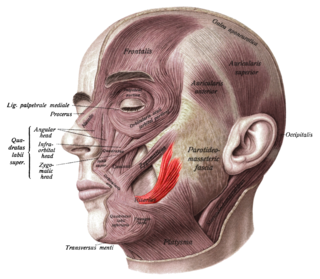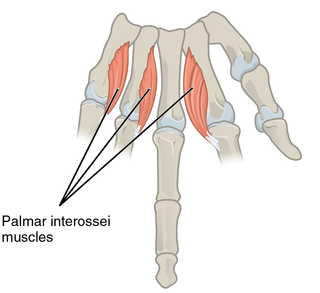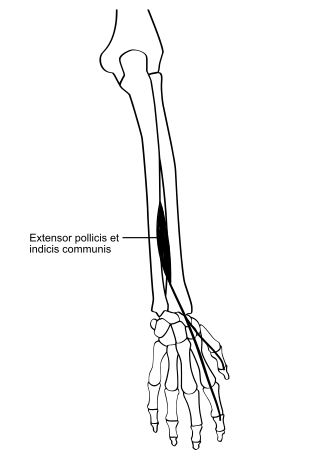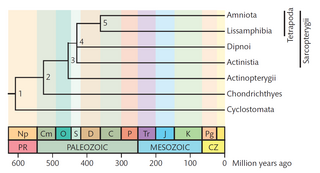Related Research Articles
Zoology is the scientific study of animals. Its studies include the structure, embryology, classification, habits, and distribution of all animals, both living and extinct, and how they interact with their ecosystems. Zoology is one of the primary branches of biology. The term is derived from Ancient Greek ζῷον, zōion ('animal'), and λόγος, logos.

The swim bladder, gas bladder, fish maw, or air bladder is an internal gas-filled organ that contributes to the ability of many bony fish to control their buoyancy, and thus to stay at their current water depth without having to expend energy in swimming. Also, the dorsal position of the swim bladder means the center of mass is below the center of volume, allowing it to act as a stabilizing agent. Additionally, the swim bladder functions as a resonating chamber, to produce or receive sound.

The brachialis, also known as the Teichmann muscle, is a muscle in the upper arm that flexes the elbow. It lies beneath the biceps brachii, and makes up part of the floor of the region known as the cubital fossa. It originates from the anterior aspect of the distal humerus; it inserts onto the tuberosity of the ulna. It is innervated by the musculocutaneous nerve, and commonly also receives additional innervation from the radial nerve. The brachialis is the prime mover of elbow flexion generating about 50% more power than the biceps.

A cephalochordate is an animal in the chordate subphylum Cephalochordata. Cephalochordates are commonly called lancelets, and possess 5 synapomorphies, or primary characteristics, that all chordates have at some point during their larval or adulthood stages. These 5 synapomorphies are a notochord, dorsal hollow nerve cord, endostyle, pharyngeal slits, and a post-anal tail. The fine structure of the cephalochordate notochord is best known for the Bahamas lancelet, Asymmetron lucayanum. Cephalochordates are represented in modern oceans by the Amphioxiformes and are commonly found in warm temperate and tropical seas worldwide. With the presence of a notochord, adult amphioxus are able to swim and tolerate the tides of coastal environments, but they are most likely to be found within the sediment of these communities.

Morphology is a branch of biology dealing with the study of the form and structure of organisms and their specific structural features.

A head is the part of an organism which usually includes the ears, brain, forehead, cheeks, chin, eyes, nose, and mouth, each of which aid in various sensory functions such as sight, hearing, smell, and taste. Some very simple animals may not have a head, but many bilaterally symmetric forms do, regardless of size.

The risorius muscle is a highly variable muscle of facial expression. It has numerous and very variable origins, and inserts into the angle of the mouth. It receives motor innervation from branches of facial nerve. It may be absent or asymmetrical in some people. It pulls the angle of the mouth sidewise, such as during smiling.

In human anatomy, the palmar or volar interossei are four muscles, one on the thumb that is occasionally missing, and three small, unipennate, central muscles in the hand that lie between the metacarpal bones and are attached to the index, ring, and little fingers. They are smaller than the dorsal interossei of the hand.
Stuart Alan Newman is a professor of cell biology and anatomy at New York Medical College in Valhalla, NY, United States. His research centers around three program areas: cellular and molecular mechanisms of vertebrate limb development, physical mechanisms of morphogenesis, and mechanisms of morphological evolution. He also writes about social and cultural aspects of biological research and technology.

The superior tarsal muscle is a smooth muscle adjoining the levator palpebrae superioris muscle that helps to raise the upper eyelid.

The Helicis minor is a small skeletal muscle. The helicis minor is an intrinsic muscle of the outer ear. The muscle runs obliques and covers the helical crus, part of the helix located just above the tragus.

The helicis major is an intrinsic muscle of the outer ear.
The posterior compartment of the forearm contains twelve muscles which primarily extend the wrist and digits. It is separated from the anterior compartment by the interosseous membrane between the radius and ulna.
Comparative physiology is a subdiscipline of physiology that studies and exploits the diversity of functional characteristics of various kinds of organisms. It is closely related to evolutionary physiology and environmental physiology. Many universities offer undergraduate courses that cover comparative aspects of animal physiology. According to Clifford Ladd Prosser, "Comparative Physiology is not so much a defined discipline as a viewpoint, a philosophy."

A hand is a prehensile, multi-fingered appendage located at the end of the forearm or forelimb of primates such as humans, chimpanzees, monkeys, and lemurs. A few other vertebrates such as the koala are often described as having "hands" instead of paws on their front limbs. The raccoon is usually described as having "hands" though opposable thumbs are lacking.

This bibliography of biology is a list of notable works, organized by subdiscipline, on the subject of biology.
The Extended Evolutionary Synthesis (EES) consists of a set of theoretical concepts argued to be more comprehensive than the earlier modern synthesis of evolutionary biology that took place between 1918 and 1942. The extended evolutionary synthesis was called for in the 1950s by C. H. Waddington, argued for on the basis of punctuated equilibrium by Stephen Jay Gould and Niles Eldredge in the 1980s, and was reconceptualized in 2007 by Massimo Pigliucci and Gerd B. Müller.

In human anatomy, the extensor pollicis et indicis communis is an aberrant muscle in the posterior compartment of forearm. It was first described in 1863. The muscle has a prevalence from 0.5% to 4%.

A timetree is a phylogenetic tree scaled to time. It shows the evolutionary relationships of a group of organisms in a temporal framework.
In biology, constructive development refers to the hypothesis that organisms shape their own developmental trajectory by constantly responding to, and causing, changes in both their internal state and their external environment. Constructive development can be contrasted with programmed development, the hypothesis that organisms develop according to a genetic program or blueprint. The constructivist perspective is found in philosophy, most notably developmental systems theory, and in the biological and social sciences, including developmental psychobiology and key themes of the extended evolutionary synthesis. Constructive development may be important to evolution because it enables organisms to produce functional phenotypes in response to genetic or environmental perturbation, and thereby contributes to adaptation and diversification.
References
- ↑ "Rui Diogo Amazon Author profile". amazon.com. Retrieved December 28, 2021.
- ↑ "Rui Diogo Research Laboratory". ruidiogolab.org. Retrieved January 3, 2022.
- ↑ "Babies in the womb have lizard-like hand muscles - BBC News". BBC News. October 2019. Retrieved October 21, 2019.
- ↑ Diogo, R.; Siomava, N.; Gitton, Y. (2019). "250-million-year-old evolutionary remnants seen in muscles of human embryos | EurekAlert! Science News". Development. Eurekalert.org. 146 (20). doi: 10.1242/dev.180349 . PMID 31575609 . Retrieved October 21, 2019.
- ↑ "Babies have lizard-like hand muscles in womb, scientists say | London Evening Standard". Standard.co.uk. October 1, 2019. Retrieved October 21, 2019.
- ↑ Jack Hardy (October 1, 2019). "Babies have 'lizard hands' in the womb but lose muscles before they are born, study claims". Telegraph.co.uk. Retrieved October 21, 2019.
- ↑ Dols, José Miguel Fernández; Russell, James Albert (2017). The Science of Facial Expression. Oxford University Press. ISBN 978-0-19-061350-1.
- ↑ Sánchez-Villagra, Marcelo R. (2018). "Evolution Driven by Organismal Behavior: A Unifying View of Life, Function, Form, Mismatches and Trends". Swiss Journal of Palaeontology. 137: 109–112. doi:10.1007/s13358-017-0139-4.
- ↑ "Rui Diogo Research Lab profile". ruidiogolab.org. Retrieved December 28, 2021.
- ↑ "HOME ANATOMY FACULTY FACULTY PROFILES". medicine.howard.edu. Retrieved December 28, 2021.
- ↑ Baas, Jeroen; Boyack, Kevin; Ioannidis, John P. A. (2020). "Bibliometrics". Data for "Updated science-wide author databases of standardized citation indicators". Vol. 2. elsevier.digitalcommonsdata.com. doi:10.17632/btchxktzyw.2 . Retrieved December 28, 2021.
- 1 2 Smulders, Tom V. (2017). "Evolution Driven by Organismal Behaviour – a Unifying View of Life, Function, Form, Mismatches, and Trends". Journal of Anatomy. 232 (2): 356–357. doi:10.1111/joa.12750.
- ↑ "Evolution Driven by Organismal Behavior". extendedevolutionarysynthesis.com. Retrieved 10 November 2023.
- ↑ Fleagle, John G. (2017). "Evolution Driven by Organismal Behavior: A Unifying View of Life, Function, Form, Mismatches, and Trends". The Quarterly Review of Biology. 92 (4): 469. doi:10.1086/694961.